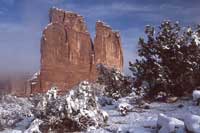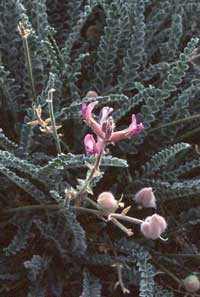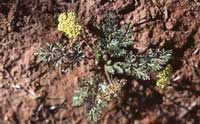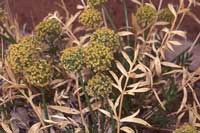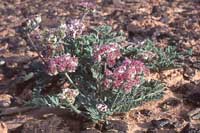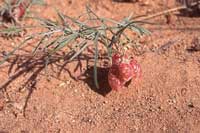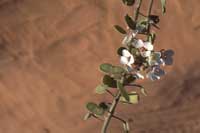The procession of spring flowers may start early in Canyon Country. Some years, the first flowers arise in mid-January poking their floral heads above the sandy desert floor. Other years, snow and ice slow the progression of budding blooms and the first flowers do not erupt until February or March.
Most often the first flower to arise is one of the Carrot family members: the Parry’s lomatium (Lomatium parryi). Easily overlooked, the dense cluster of tiny yellow flowers are borne in an umbrella-like pattern known as an “umbel.” This arrangement provides for the family name, Umbelliferae.
In a break from tradition, the Parry’s lomatium sends up these flowering heads long before the leaves appear. Arising on reddish stems, the leafless stalks range from a couple of inches high to nearly 2 feet tall. Last year’s dried leaves may still be present when the plant’s bloom.
Named in honor of Charles Christopher Parry (1823-1890), he was the first official botanist of the U.S. Department of Agriculture. He joined several survey parties to the American West where he collected a number of species new to science.
Another lomatium that blooms early in the year is the Canyonlands biscuitroot (Lomatium latilobum). Found growing in sandy sites in close proximity to the Entrada Sandstone, these plants only grow in several sites in the Four Corners area. The biscuitroots grow in large clumps and the highly dissected leaves are somewhat similar to those of a domesticated relative, the carrot.
Named for its restricted range in the Canyonlands region, this Carrot family member also sends up clusters of tiny yellow flowers arranged in an umbel. Native Americans harvested the plant’s taproots and pulverized the roots into flour; hence, the common name. Lomatium means “fringed” and refers to the wavy edges on the seeds.
Other members of the Carrot family that start blooming in early spring include members of the Cymopterus genus. There is the Fendler spring-parsley and the basin white-cup spring parsley that have yellow and whitish flowers, respectively. The highly divided leaves resemble those of the herb parsley, hence the reference in the common name.
Like the lomatiums, these spring-parsleys also have winged fruit. Some species have papery wings on the seeds; others bear corky wavy edges.
Two other plant families that are well represented with early spring wildflowers are the Mustard family (Brassicaceae) and the Pea Family (Fabaceae). Flowers in the Mustard family generally have four petals and 6 stamens. Both the petals and stamens are arranged in a cross pattern, and this arrangement derives another name for the family the Cruciferae.
One of my favorite “crucifs” is spectacle-pod (Dithyrea wislizenii). Two rounded seedpods are fused together along a common midline and resemble a pair of spectacles. The species name honors Friedrich Adolph Wislizenus (1810-1889), a German immigrant who joined a trading caravan to Mexico in 1846 where he collected specimens of the local flora and fauna.
The Pea family is well represented by early spring flowers. The pinkish-purple blooms of rimrock milkvetch, crescent milkvetch, Preuss’ milkvetch, woolly locoweed, and painted milkvetch. All have interesting seedpods, but those of the painted milkvetch are inflated and have reddish mottling that resembles painted pottery.
Although these flowers may not be the showiest desert wildflowers compared to the cacti and globemallows that bloom later in spring, their presence marks the seasonal transition and heralds the return of spring. Long may they bloom!


